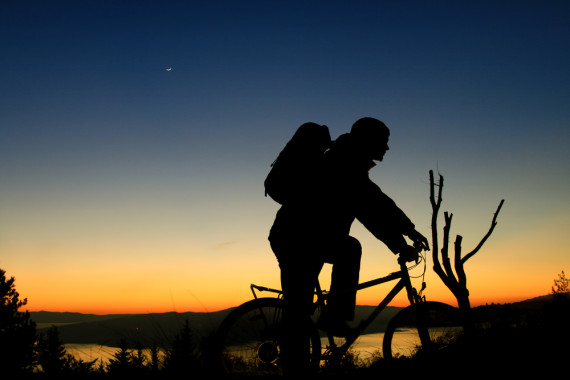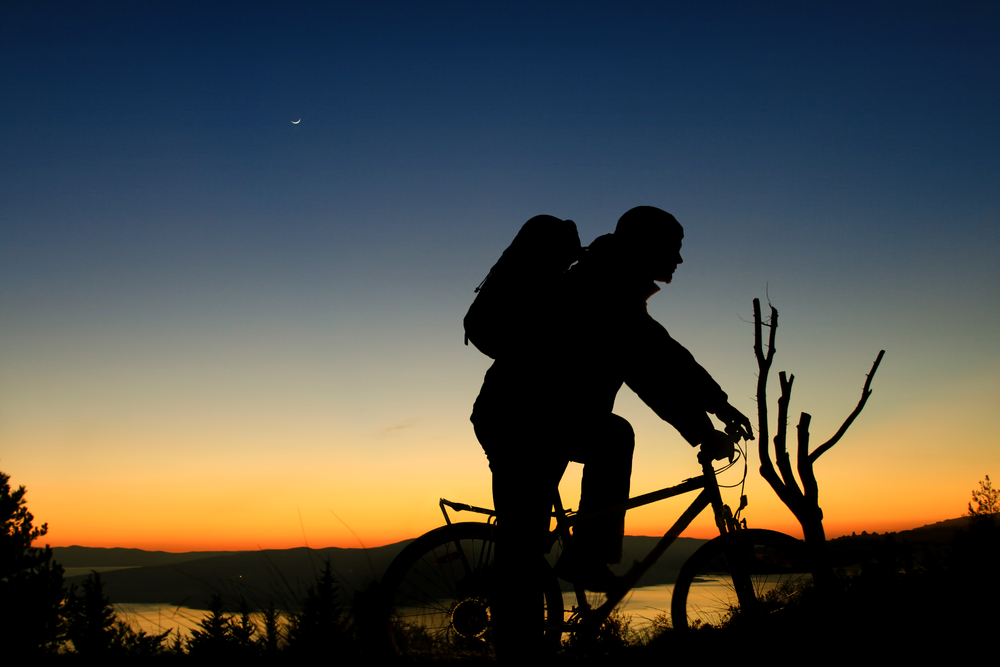Silhouette of Cyclist photo via Shutterstock
By Diana Smith
Cycling. It’s one of the greenest, most cost efficient ways to travel, and also one of the most liberating. So why not kick things up a bit and take a road trip not by car but by bike? Venture outside your neighborhood or your usual route to work. Explore bike camping, or maybe cruise across a few states or even the whole country. Interested? Check out this comprehensive guide to bike touring.
GROUP & SOLO TOURING
It probably goes without saying that your experience, comfort level, and budget will mainly determine what kind of touring is best for you. While there are advantages and disadvantages to each, most importantly, make sure that you’ll be able to handle the route and pace of whichever tour you choose. Practice rides are recommended.
Group Touring:
This is a safe option for those new to extensive bike trips. Whether it’s a group of your fellow cyclists or a professionally organized tour from companies like REI Adventures or the Adventure Cycling Association the two common categories of group tours are supported and unsupported.
Supported bike tours, or vehicle-supported bike tours, are where the cyclists do not carry their own gear, but have it transported by vehicle to their daily destinations. These tours give you freedom from the weight of your equipment, but they can also be costly and the vehicles may not always be able to travel to remote locations. The more professionally organized supported tours, however, do provide roadside assistance and some offer services where they set-up your equipment for you and provide meals.
Unsupported bike tours are when the cyclists transport their own equipment on their bike. These tours tend to be more budget-friendly and can be a little less rigid in structure. And because you’re with a group, you can often consolidate and share equipment such as tents, tools, and food supplies.
Solo Touring:
For the more advanced or self-reliant cyclist, solo touring provides the most freedom, but also requires the most responsibility. Solo cyclists tend to either do self-supported tours or credit card tours.
Self-supported touring means the cyclist carries all of their equipment and makes only the occasional stop for food (similar to the unsupported group bike tours). This kind of touring is the most cost efficient. (Read: campsites offer very low rates to cyclists!) One disadvantage is that this type of touring requires more gear as opposed to the unsupported group bike tours. In turn, more gear and weight means more energy and effort is required from the rider.
Credit card touring is when the cyclist carries the minimal gear and then pays for accommodations and meals along the way. As REI’s site explains, this kind of touring affords comfortable, warm places to stay, but riders may need to stick to an itinerary as accommodations will most often need to be booked in advance, especially in the busy summer months.
If at any time during your ventures you find yourself injured, out of time, or without enough energy to bike back, keep in mind that Amtrak offers zero to low-fee rates for transporting bikes.
MAPS, ROUTES & TERRAIN
Local bike shops and some Department of Transportation offices will have maps specific to cycling. Some city maps will even display where various bike shops and mechanics are located in case you need assistance at any point during your trip (something to research ahead of time). Other great resources like the Adventure Cycling Association and the Bike Across USA website, feature common routes and cycling information.
Whether you’re on a guided tour, travelling with friends, or riding solo, you’ll want to be certain of your journey’s topography and your ability to meet these challenges. Riding 30 miles each day may be an easy feat, but can you make 100 if necessary? Can you take steep grades for miles at a time? Research your intended route and make any plans for alternate paths in places that might be too challenging, or find a tour that better suits your capabilities. Lastly, plan accordingly for any construction or road closures.
THE BIKE
From the frame down to the tires, your ride will need to withstand your journey and the weight of your gear from start to finish. This may or may not be the bike you use on a daily basis. While some bikes maneuver well over multiple surfaces, they may not hold up under a lot of weight. Other bikes can carry a large load, but are not designed to absorb large amounts of shock. Wider tires are good for off-road traction, but because they take up more surface area, are not the best options for speed or paved roads. Before spending money on a new bike, consult your local bike mechanic. Sometimes a few modifications are all that’s needed.
If you are looking to make an investment, touring bikes can be a good option for long distances. They are durable and often come equipped with mounting bolts for racks and cargo. These bikes, however, are primarily designed to be ridden on pavement.
Mountain bikes are always a popular choice as they ride well in rugged areas and can be outfitted for pavement. Hybrid bikes can also work for some tours, performing nicely on streets and dirt trails. Both of these are not necessarily built for speed and are limited in how much weight can be carried, so they might be better for group or credit card tours.
TOOLS & MAINTENANCE
While you certainly don’t need to be a mechanic, you should know how to do some basic maintenance: flat tires, broken chains, and other breakdowns are likely to occur when on the road, so be sure to prep yourself for any of these mishaps. Carry a light, compact set of tools specific to your bike and to your trip.
Some basic tools to bring are:
- Tire Pump
- Spare tubes
- Tire levers
- Patch kit
- Chain tool
- Bicycle Multi-tool/Mini-tool— many include a chain tool or spoke wrench
For lengthy or more remote adventures, you may want to pack more than the basics. Additional tools to consider are:
- Folding tire— for when your patch kit has run dry
- Brake tools or a brake wrench
- Spoke wrench
- Spare spoke with nipple
- Spare chain links with a master link
- Chain lube— for rain or heavy dust
- Zip ties
- Rags— to wipe your hands
If needed, Better World Club offers its members nationwide emergency roadside assistance. And AAA offers assistance to cyclists in the Pacific Northwest, Southern New England, Colorado and Minneapolis.
LAWS & SAFETY
It’s always important to know your rights as a cyclist. If you’ll be traveling through multiple states, research each state’s cycling laws as they do vary. The DMV for each state often lists these and Bike League, which provides a dropdown menu of each state and their cycling laws are good resources. Regardless of what the law allows, please, wear a helmet and carry a first-aid kit.
FOOD & WEATHER
You’ll need to pack light for most tours. This goes for food too. Dried foods are sustainable and light and work well for touring. Camping stores often sell cookbooks and equipment, like food dehydrators, which can help with planning and packing food for the road.
While you’ll want to check the weather before your journey to help you determine what to pack, rain gear is always a must. And keep your rain gear at the top of your bag. The last thing you want is to be searching for it in a sudden rainstorm.
STAYING HEALTHY
“Drink before you’re thirsty and eat before you’re hungry,” advised bike mechanic Marc Dyer of Portland, Ore. Between the long distances, the inclines, and your gear, your ride will require a fair amount of exertion. And don’t forget to stretch throughout your ride!
Happy trails!
 About the Writer
About the Writer
Diana Smith is a Brooklyn-based writer and photographer originally from the San Francisco Bay Area. In addition to her travels in Europe, she has also explored the US, adventuring from coast to coast and back again by way of the road. When Diana isn’t road-tripping she volunteers with a non-profit AIDS organization in New York City. Diana holds a BA in film and media studies from the University of California-Irvine and an MFA in creative writing from Emerson College. To view more excerpts from her travels visit RoadsAmerica.com or find her on Twitter @Roads_America.
Feature photo of silhouette of cyclist via Shutterstock




